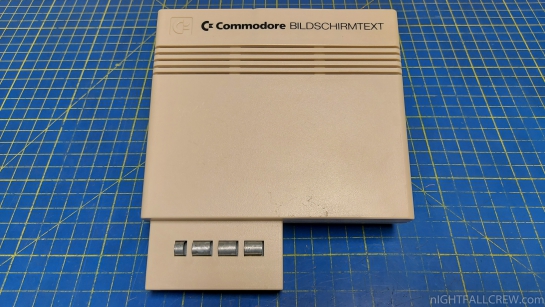Commodore (Siemens) Bildschirmtext II Decoder Cartridge

Bildschirmtext (Btx) was a German online service that existed from 1983 to 2001.
To use the service with a C64, this decoder cartridge was required, which connected to the expansion port.
The cartridge is actually a Siemens product, it’s just Commodore-branded.
The sticker says:
- SIEMENS
- Universal Btx Decoder
- S30817-S721-B101-7/02 EX/W8
- A30817-X732-B100-4-11
- Commodore Artikel Nr. 606491
The box with the Deutsche Bundespost logo is the registration (A506 131V). At the time, only explicitly Post-approved devices and software were allowed to be used for participating in Bildschirmtext.
(This is the “Btx Decoder Modul II”, even though the cartridge doesn’t say so. There was a completely different first model.)
There are three DIN ports at the back, from left to right:
- Modem: This connects to the proprietary Deutsche Bundespost “DBT-03” modem (1200 baud down, 75 baud up).
- RGB: This is for connecting an analog RGB monitor.
- FBAS: This port is identical to the C64 video port and allows using a C64 monitor.
The Post-approval for participating in Bildschirmtext required the decoder to be able to show a pixel-exact image of the service (480×240 pixels with 32 out of 4096 colors)1. Since the VIC-II in the C64 could not meet this, the decoder cartridge had its own video controller and therefore its own video ports.
The board reveals that the cartridge doesn’t only have its own video chip, it also has its own CPU, RAM and ROM – it’s a complete computer that only connects to the C64 in order to reuse the keyboard and the disk drive.
These are the major chips:
- Motorola MC6803: a 6800-family microcontroller
- Motorola MC68HC34: Dual-Port Memory Unit
- 64 KB RAM (two 41464 64Kx4 DRAM)
- 32 KB EPROM
- D65040GF206: NEC µPD65000 series CMOS gate array
The communication with the modem, the decoding of the CEPT data stream and the interaction with the Btx service are handled by 6800 CPU and the software in the EPROM.
I am assuming the software writes the RGB values of every single scanline into the dual-port memory in real-time, which the gate array then reads to generate the video signal – like on the Atari VCS and the Sinclair ZX81. This keeps the complexity of the video hardware minimal.
The chipset and the firmware are probably very similar to the technology used in dedicated Bildschirmtext terminals.
Gallery:
source: pagetable.com
















This is what happens when old men in suits, totally out of touch with what a consumer would want, gets to make important decisions.
There is a reson for Videotex being a success in France, as Minitel, and a failure (as a mass market consumer product) elsewhere. I bet that the price were a great reason for it not being a success in West Germany. Meanwhile in Sweden we had a ROM cartridge called Teledata 64 with just an eprom with software for the C64, and a modem mostly consisting of an AMD WorldModem chip, a few switches and a realay, connected to the C64 user port (much like a ram expansion on a ZX81). It still was a failure but that was due to the same kind of old men in suits making poor decisions, filling the major state telecom monopoly Videotex service with stuff that were only of interest to other old men in suits, like stock exchange rates.